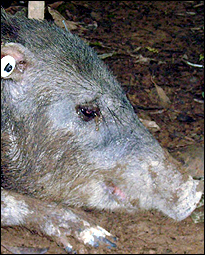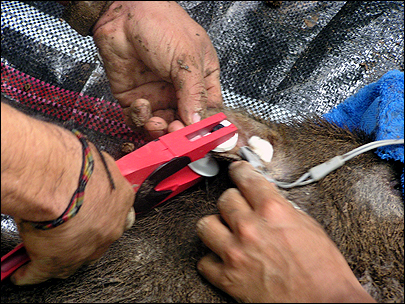Radio frequency technology has been utilized for many years to track wildlife, and is often incorporated with sophisticated GPS tracking devices so researchers can track wildlife remotely—combined, at times, with aerial inspections using planes or helicopters.
But in its study of the white-lipped peccary, a type of wild pig native to the Amazon and endangered by deforestation and hunting, the World Wildlife Fund (WWF) has found inexpensive, passive RFID technology adequate for its research into the animals’ behavior.
WWF is studying peccaries as part of a half-decade-long research study, and is using the data it collects—in tandem with other data collected tracking jaguars and macaws—as part of a large project designed to study biodiversity in the Amazon. The project will help determine how large an area wide-ranging birds and mammals need to survive in healthy populations.
WWF hopes the data it collects will help it ascertain whether Amazonian species need additional protected parkland to thrive. In addition, the organization is using the project to explore ways it might optimize RFID technology for use in wildlife tracking in the Amazon, where capturing and tagging animals is difficult and time-consuming, and where long-life lightweight tags are needed.

To track the peccaries, WWF biologists installed salt and mineral licks throughout the animals’ habitat, deploying a wireless RFID reader next to each. The scientists then captured, tranquilized and tagged the peccaries they planned to study, using ear tags made by Allflex and containing Texas Instruments‘ Half-Duplex (HDX) low-frequency (134 kHz) inlays compliant with the ISO 11785 air-interface standard.
When a tagged peccary approaches a salt lick, its ear tag enters the read range of the interrogator, which records the tag ID in its onboard memory, as well as a timestamp for each read. During periodic inspections of the salt licks, researchers use handheld computers to pull the tag data from the readers, along with the reader ID, so they can link the tag and time data with each interrogator’s location to map the animal’s movements and behaviors.
Although the low-frequency tags have a short read range and do not support fast data transmissions, the TI tags work well for the peccary application because the reading environment is highly humid, often rainy. That moisture, as well as the wetness of the peccary’s fur in the rain, poses a challenge to reading higher-frequency tags. Moreover, because a peccary often lingers in front of the salt lick, there is plenty of time for the readers to pick up its tag ID.
Aside from learning more about the peccaries’ behavior, WWF also hopes the data collected in the study can be leveraged to influence land management based on ecological needs and the animal habitat in the Amazon, rather than on political or land-border factors.


